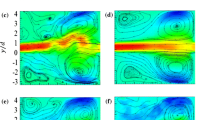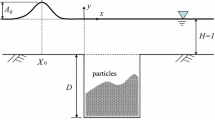Abstract
Measurements were carried out in a shallow open cavity with particle image velocimetry technique. The cavity has a length- to-depth ratio of 4:1, and the upstream inflow conditions include laminar, transient, and turbulent regimes at seven different Reynolds numbers. The measured instantaneous velocities were analyzed through ensemble average, vortex extraction, and proper orthogonal decomposition (POD) to investigate overall flow circulations, Reynolds stress distribution, spanwise vortex population, and the characteristics of the POD modes. The results reveal distinctive Reynolds number dependence of the cavity flow, e.g. an increase in Reynolds number results in constant migration of the overall circulation, enhancement of Reynolds stress, reduction of correlation between vortex and Reynolds stress, and decrease of fractional energy of the characteristic POD modes. Finally, a phenomenological model was proposed to describe various features of cavity flow.
Similar content being viewed by others
References
Haigermoser C. Application of an acoustic analogy to PIV data from rectangular cavity flows. Exp Fluids, 2009, 47: 145–157
Faure T M, Pastur L, Lusseyran F, et al. Three-dimensional centrifugal instabilities development inside a parallelepipedic open cavity of various shape. Exp Fluids, 2009, 47: 395–410
Haigermoser C, Scarano F, Onorato M. Investigation of the flow in a rectangular cavity using tomographic and time-resolved PIV. In: Proceedings of the 26th international congress of the aeronautical sciences (ICAS). Ancorage, 2008. 14–19
Özsoy E, Rambaud P, Stitou A, et al. Vortex characteristics in laminar cavity flow at very low Mach number. Exp Fluids, 2005, 38: 133–145
Lin J C, Rockwell D. Organized oscillations of initially turbulent flow past a cavity. AIAA J, 2001, 39: 1139–1151
Wang H, Wang Z, Sun M, et al. Nonlinear analysis of combustion oscillations in a cavity-based supersonic combustor. Sci China Tech Sci, 2013, 56:1093–1101
Sarohia V. Experimental investigation of oscillations in flows over shallow cavities. AIAA J, 1977, 15: 984–991
Faure T M, Adrianos P, Lusseyran F, et al. Visualizations of the flow inside an open cavity at medium range Reynolds numbers. Exp Fluids, 2007, 42: 169–184
Zdanski P S B, Ortega M A, Fico Jr N G C R. Numerical study of the flow over shallow cavities. Comput Fluids, 2003, 32: 953–974
Manovski P, Giacobello M, Soria J. Particle image velocimetry measurements over an aerodynamically open two-dimensional cavity. In: 16th Australasian Fluid Mechanics Conference. Crown Plaza, Gold Coast, 2007, 677–683
Grace S M, Dewar W G, Wroblewski D E. Experimental investigation of the flow characteristics within a shallow wall cavity for both laminar and turbulent upstream boundary layers. Exp Fluids, 2004, 36: 791–804
Ding D, Wu S. Direct numerical simulation of turbulent flow over backward-facing at high Reynolds numbers. Sci China Tech Sci, 2012, 55: 3213–3222
Holman J P. Heat Transfer. New York: McGraw-Hill, 1986. 210
Scarano F. Iterative image deformation methods in PIV. Meas Sci Technol, 2002, 13: R1–R19
Astarita T, Cardone G. Analysis of interpolation schemes for image deformation methods in PIV. Exp Fluids, 2005, 38: 233–243
Forliti D J, Strykowski P J, Debatin K. Bias and precision errors of digital particle image velocimetry. Exp Fluids, 2000, 28: 436–447
Astarita T. Analysis of velocity interpolation schemes for image deformation methods in PIV. Exp Fluids, 2008, 45: 257–266
Westerweel J, Scarano F. Universal outlier detection for PIV data. Exp Fluids, 2005, 39: 1096–1100
Efron B, Tibshirani R. An Introduction to the Bootstrap. New York: Chapman and Hall, 1993. 27–36
Zhou J, Adrian R J, Balachandar S, et al. Mechanisms for generating coherent packets of hairpin vortices in channel flow. J Fluid Mech, 1999, 387: 353–396
Jeong J, Hussain F. On the identification of a vortex. J Fluid Mech, 1995, 285: 69–94
Chong M S, Perry A E, Cantwell B J. A general classification of three-dimensional flow fields. Phys Fluids, 1990, 2: 408–420
Hunt J C R, Wray A A, Moin P. Eddies, streams, and convergence zones in turbulent flows. In: Proceedings of the Summer Program, Center of Turbulence Research. NASA Ames/Stanford University, USA, 1988. 193–208
Wu Y, Christensen K T. Population trends of spanwise vortices in wall turbulence. J Fluid Mech, 2006, 568: 55–76
Zhong Q, Li D, Chen Q, et al. Coherent structure models for open channel flows (in Chinese). J Tsinghua Univ (Sci & Tech), 2012, 52: 730–737
Shinneeb A, Bugg J D, Balachandar R. Quantitative investigation of vortical structures in the near-exit region of an axisymmetric turbulent jet. J Turbul, 2008, 9: 1–20
Liu Z, Adrian R J, Hanratty T J. Large-scale modes of turbulent channel flow: transport and structure. J Fluid Mech, 2001, 448: 53–80
Holmes P, Lumley J L, Berkooz G. Turbulence, Coherent Structures, Dynamical Systems and Symmetry. New York: Cambridge Univ Press, 1996. 86–91
Pastur L R, Lusseyran F, Fraigneau Y, et al. Determining the spectral signature of spatial coherent structures in an open cavity flow. Phys Rev E, 2005, 72: 65301
Kang W, Sung H J. Large-scale structures of turbulent flows over an open cavity. J Fluid Struct, 2009, 25: 1318–1333
Shinneeb A. Confinement Effects in Shallow-Water Jets. Dissertation for the Doctoral Degree. Saskatoon, Canada: University of Saskatchewan, 2006
Uijttewaal W S J, Lehmann D, Van Mazijk A. Exchange processes between a river and its groyne fields: Model experiments. J Hydraul Eng-ASCE, 2001, 127: 928–936
Sanjou M, Akimoto T, Okamoto T. Three-dimensional turbulence structure of rectangular side-cavity zone in open-channel streams. Intl J River Basin Management, 2012, 10: 293–305
Ghia U, Ghia K N, Shin C T. High-Resolutions for incompressible flow using the Navier-Stokes equations and a multigrid method. J Comput Phys, 1982, 48: 387–411
Yossef M F M, de Vriend H J. Flow details near river groynes: Experimental investigation. J Hydraul Eng-ASCE, 2011, 137: 504–516
Author information
Authors and Affiliations
Corresponding author
Rights and permissions
About this article
Cite this article
Chen, H., Zhong, Q., Wang, X. et al. Reynolds number dependence of flow past a shallow open cavity. Sci. China Technol. Sci. 57, 2161–2171 (2014). https://doi.org/10.1007/s11431-014-5649-3
Received:
Accepted:
Published:
Issue Date:
DOI: https://doi.org/10.1007/s11431-014-5649-3




